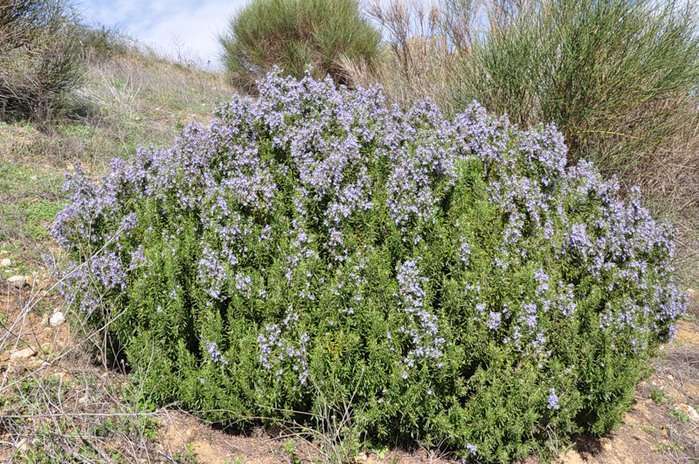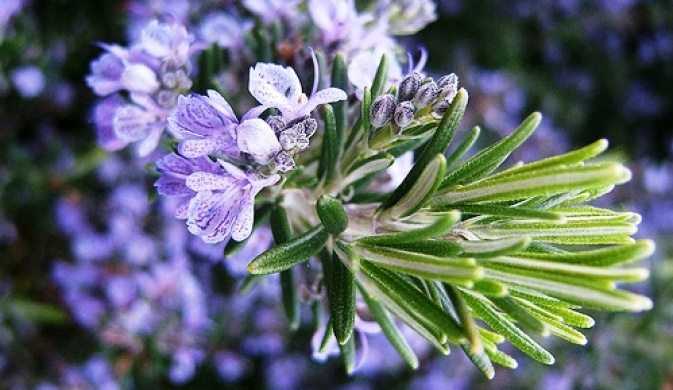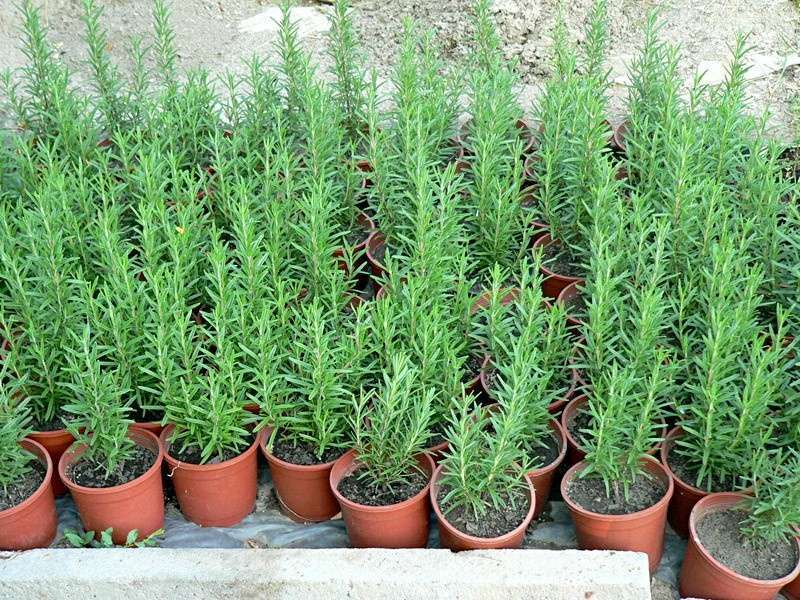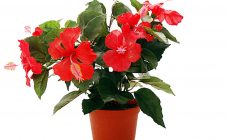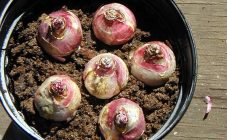Content:
The evergreen shrub rosemary belongs to the Lamiaceae family. He has very beautiful and fragrant flowers. In nature, it can be found in the Mediterranean, North Africa and Southern Europe. Rosemary is easy to grow at home. Readers are interested in how rosemary looks like growing caring for it.
Description
The plant does not grow wild in Russia. Rosemary is a shrub with a height of 0.5 to 2 m. The branches are tetrahedral, covered with small down. The leaves have very small petioles, evergreen. In addition to the name rosemary, another name for the plant is sea dew.
The flowers of rosemary are sessile and have a blue-violet hue. Outside, the flower is slightly pubescent. The upper lip of this flower has a notched shape.
Rosemary fruit is an egg-shaped nut.
The plant blooms in spring. Fruit ripening ends by September.
Many gardeners are interested in how rosemary is useful. The plant contains essential oils. A refreshing rosemary scent comes from the presence of alpha-pinene in the composition. Carnosol and rosmarinic acid give the plant a specific bitter taste, thanks to which it is used in cooking. Rosemary leaves contain the flavonoids apigenin and luteolin.
Essential oils have a beneficial effect on the body, which makes a person easy to calm down. The specific healing scent improves a person's mood. It improves memory and concentration, which makes it recommended for exam preparation.
In the form of an infusion, the herb is used to treat bronchial asthma, pathologies of the upper respiratory tract. The oil is also useful for the treatment of gastrointestinal pathologies: it perfectly improves appetite. It is recommended to inhale the oil of this plant to reduce the intensity of the headache.
The infusion of this herb with the addition of lavender has a positive effect on health, in particular, on the movement of blood through the vessels. It helps to treat neuritis and gout. Rosemary oil is used in aroma therapy and in cosmetology, it is excellent in lowering blood pressure.
Reproduction
Rosemary can be grown by dividing the bush, by seeds, layering, cuttings. All varieties of seeds are sold in flower shops. The seeds should be placed at a shallow depth. The first shoots will emerge in about 3 weeks. Watering the sprouts is best done with a sprayer.
Propagation of rosemary by cuttings is justified if there is at least one adult plant on the farm. The length of the shoot should be at least 10 cm. Tear off the leaves from the bottom, plant the cuttings in pots filled with fertile substrate. The depth of placing the cuttings in the ground is no more than 5 cm. In this case, the ground must be carefully tamped. A small amount of a solution that stimulates root formation should be added to the ground. So the process will take root much faster.
The earth must be well moistened so that it is completely saturated with liquid. Around the perimeter of the pot, you need to drive small pegs into the ground and pull a plastic bag over them. So at home you get a miniature greenhouse. If the cuttings are rooted, young leaves will appear on them, they need to be planted in pots.
Planting rosemary at home
After the gardener has acquired rosemary, planting and care at home are carried out taking into account its photophilousness. A prerequisite for growing is a sufficient amount of sunlight. When choosing a place, you need to take care that the plant does not shade. In winter, you need to take care of additional lighting sources.
Prepare the soil before planting. It should be neutral or slightly alkaline, but not sour. If it does not fit the required parameters, a little lime is added to it.
When choosing a pot for a plant, you need to consider that its root system is growing. Therefore, the height of the container must be at least 20 cm, the width must be at least 25 cm.
In the garden, this herb will grow well on the southern slopes. It is necessary to take it out of the pot only when the threat of a return of night frosts has passed. The preferred planting site is only sunny. If you plant a plant in the shade, it will not grow.
When planting grass in the garden, the soil is loosened. It grows very poorly on dense soils. It should be watered sparingly, because it tolerates drought well, there is no need to overmoisten the soil.
Sowing seeds in open soil is possible only in the climatic conditions of southern Russia. Cuttings are planted in a greenhouse. In a row, the distance between them should be at least 10 cm, between rows - at least 25 cm. It is recommended to mulch the soil, using peat. When rooting cuttings, the ambient temperature should be kept at least 20 degrees.
Plant care
In the case of growing rosemary at home, it is resistant to harmful factors and does not require particularly careful maintenance. He loves light, tolerates periods of drought well. In areas with frosty winters, planting in a pot is the best option for growing rosemary. In the summer it is planted in open soil. If the plant is planted out of a pot into open ground, then soon it will be very lush.
By autumn, the "sea dew" must again be transplanted into the pot (along with the soil). Before this, all dried areas are separated from the bush. For the winter, the plant should be watered very rarely, transfer it to a room with a temperature of no more than 10 degrees.
Lighting
Rosemary is photophilous, it perfectly tolerates the bright rays of the sun. In autumn and winter, the rosemary pot is best placed on the south side.
Temperature conditions
Rosemary grows comfortably at room temperature. During the summer heat, provided there is sufficient watering, it will also not suffer. For the winter, rosemary is transferred to a cooler room. In this case, it is not necessary to allow the temperature to drop below zero.
In winter, rosemary will feel best in a cold room with temperatures around 8 degrees.
Watering and humidity
Rosemary is a drought tolerant plant. Before the development of young shoots, it must be watered. In summer, the main rule is not to overflow the plant so that the roots do not rot in it.
In winter, watering should be reduced to about 2 times per month. Care must be taken so that the earth does not dry out.
Transplant and feeding
If rosemary does not fit in open ground for the summer, it is preferable to replant it in the spring once every 2 years. During transplantation, the container must be taken slightly larger than the previous one. There should be a drainage layer in the pot.
The mixture of soil should be loose and fertile, neutral reaction.The best mixture for rosemary consists of 2 parts of leaf and 2 parts of sod land, 1 part each of humus, sand, peat. The plant will not grow on acidic soil; lime must be used to change its properties.
It is necessary to feed this plant during the period of intensive growth. The frequency of feeding is 2 times a month. For this, organic and mineral fertilizers should be used. Rosemary needs calcium fertilizers for the best growth.
Pruning
In June, the rosemary should be trimmed a little. If cuttings are formed after pruning, then they can be planted in the ground. Rejuvenating pruning should be done in late winter and early spring.
Once every 7 years or so, the rosemary is pruned completely to soil level. This is done to rejuvenate the plant.
Pest control
Since the plant has insecticidal properties, pests do not take root on it. Rarely, when the temperature changes, powdery mildew appears on the leaves. To prevent it from appearing, the shrub must be transferred in cold weather to a room with a stable cool temperature.
Rosemary is a beautiful plant that will not only decorate the garden area, but will also be of great benefit. It can be used both as a medicine and as a seasoning. When planting, it is advisable to follow the rules of agricultural technology.
